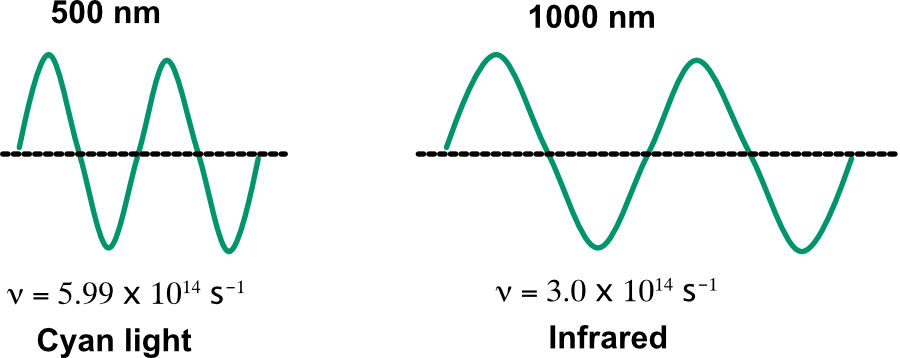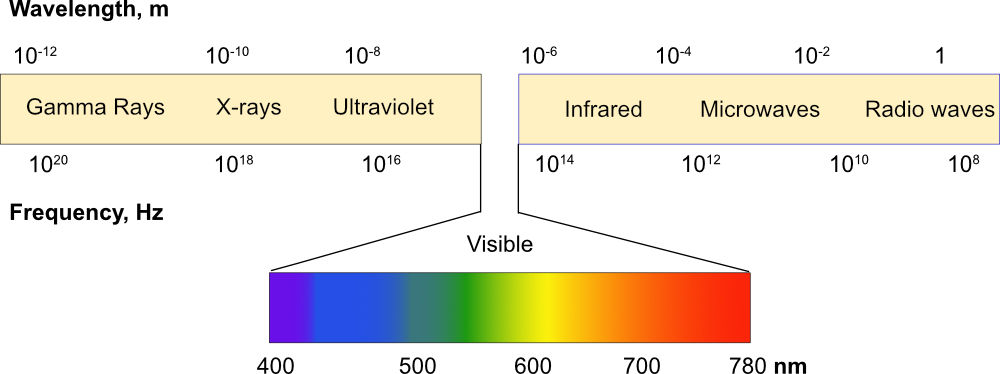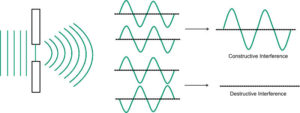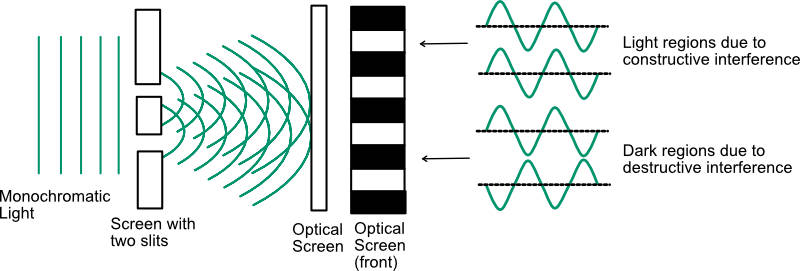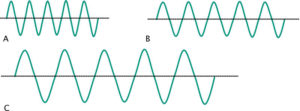Before we can understand electronic structure of atoms, we need to learn about light. The light we can see is called visible light and is a small part of the full electromagnetic spectrum. Spectroscopy is the study of the interaction of light (radiant energy) with matter. In addition to visible light, there are radio waves, infrared, x-rays, etc. All electromagnetic radiation travel through a vacuum at the speed of light, 2.998 x 108 m/s. All have wave characteristics which are very similar to the waves that move through the water in a sea. The energy of the sea waves is due to the up and down periodic movement of the water. Similar to the sea waves, electromagnetic radiation can be characterized by three variables: a wavelength, a frequency, and an amplitude.
The wavelength, λ, is the distance from one wave peak to the next (or the distance from one trough to the next). The frequency, ν, is the number of wave peaks that move past a given point per second. The unit of frequency is reciprocal seconds, s-1 also called hertz, Hz, and 1 Hz = 1 s-1. The aplitude is the height of the peak to the center between the peak and trough. The intensity of a wave is proportional to the square of the amplitude. The amplitude corresponds to the brightness or dimness of a wave. Two waves can have the same wavelength and frequency but different amplitudes — one wave might be very bright and the other can be less bright.
In the figure below, are two waves with one having a wavelength of 500 nm and the other 1000 nm. The wavelength of 500 nm corresponds to cyan light while the wavelength of 1000 nm corresponds to near infrared radiation.
In the following figure, the electromagnetic spectrum is shown. We can see that from radio waves to gamma rays, the wavelengths of light decrease while the frequency increases. The gamma rays have the highest frequencies and shortest wavelengths, while the radio waves have the smallest frequencies and longer wavelengths. The units of wavelength depend on the region of the electromagnetic spectrum under study. The visible region is a small portion of the electromagnetic spectrum representing all of the colors of light we can see. We report the wavelengths in the visible region in nm. Each color in the visible region of the electromagnetic spectrum corresponds to a wavelength of visible light. For example at 500 nm the light is blue-green and at approximately 700 nm the light is red.
There is an inverse relationship between wavelength and frequency. If the frequency and wavelength are multiplied, the speed of the wave is calculated. In a vacuum, the speed of light, c, is 2.99792458 x 108 m/s. We usually round this to 3.00 x 108 m/s. The equation is written as:
Electromagnetic radiation with shorter wavelengths have higher frequencies, and longer wavelengths correspond to lower frequencies. If one variable is known, the other can be calculated with the equation.
White light is all of the wavelengths of light in the visible spectrum. Dispersion is when white light separates into its component wavelengths when passed through a prism or other refracting object. A rainbow is an example of dispersion. White light is dispersed through raindrops to produce the rainbow.

“Europa Rainbow” by Robert Couse-Baker is licensed with CC BY 2.0. To view a copy of this license, visit https://creativecommons.org/licenses/by/2.0/
Notice, the violet light is bended more than the red light in the rainbow and blue light is bended more than orange light. Another property of light is diffraction. Diffraction is when a light wave strikes the edge of an object and bends around it. Another property of light is diffraction. Light waves can interact constructively or destructively. Constructive interference is when the crests of waves coincide and the amplitudes add to form a brighter region. Destructive interference is when waves are out of phase, the crests do not coincide, and the amplitudes will cancel and form a dark region. Diffraction is observed when you see a street light through a mesh curtain. The image of the street light is blurred because of diffraction.
Scientists had been studying the wavelike properties of light for many years. In the early 1800s, Thomas Young (1773 – 1829), a British physician and physicist, was able to demonstrate that light was made up of waves in the double slit experiment. If monochromatic light, light of one single wavelength, is passed through a screen with two slits, an interference pattern is observed at the detector. The waves that pass through the two slits are diffracted. Constructive interference results in bright bands, and destructive interference results in the dark bands on the detector. It is because of the wave properties of light that interference is observed.
In the next study guide, we will discuss the particle properties of radiant energy.
Exercises
Exercise 1. An FM radio station broadcasts on a frequency of 96.8 MHz. What is the wavelength of these radio waves in meters?
Exercise 2. A neon laser emits light at a wavelength of 625 nm. What is the frequency of this radiation, in Hz?
Exercise 3. Consider the following figure.
b) Which would be the brightest?
c) Which would have the longer wavelength?
Exercise 4. In one type of optical fiber, the wavelength of transmitted light is 1.2 x 103 nm.
b) If the fiber optic cable is 14 km long, how long will it take for the signal to travel that distance? Assume the speed of light in the cable is 2.998 x 108 m/s .
Check Solutions/Answers to Exercises
Back to Electronic Structure of Atoms
Back to General Chemistry 1 Study Guides
Back to Home Page


